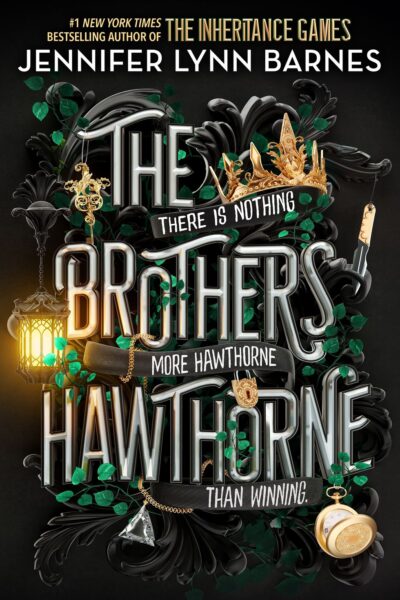
The Brothers Hawthorne
CHAPTER 33: JAMESON
by Barnes, Jennifer LynnThe chapter opens with Jameson engaging in a game of whist with Branford, who plays with cold efficiency and dismissive attitude. Despite Jameson’s quick learning, Branford’s superior skill leads their team to lose, though Branford’s partner, Zella, remains indifferent. Branford’s abrupt shift from standing to sitting signals the arrival of Avery and a mysterious man at the top of a grand staircase, disrupting the room’s dynamics. The man, referred to as the Proprietor, commands immediate respect, evident as the entire room inclines their heads in deference.
The Proprietor is described as an enigmatic figure with slicked-back white hair and a platinum cane, exuding authority. His presence evokes a regal atmosphere, as if the attendees are bowing to royalty. Avery, accompanying him, takes his arm as they descend the staircase, further emphasizing his significance. Branford acknowledges the Proprietor with a subtle nod, hinting at an underlying connection or hierarchy. The scene sets the stage for a power dynamic, with the Proprietor at its center and the others reacting to his dominance.
Jameson, however, defies the unspoken rules of the room. Unlike the others, he refuses to lower his head or remain seated. Instead, he boldly approaches Avery and the Proprietor, making direct eye contact and even winking at the latter. This act of defiance highlights Jameson’s fearless and rebellious nature, contrasting sharply with the submissive behavior of the crowd. His actions suggest a willingness to challenge authority and embrace risk, regardless of potential consequences.
The chapter concludes with Jameson’s audacious gesture, leaving the reader to ponder the implications of his defiance. His wink at the Proprietor underscores his confidence and unpredictability, while the final line—“What was life without a little risk?”—encapsulates his daring philosophy. This moment sets up tension for future interactions, as Jameson’s refusal to conform may have significant repercussions in the unfolding narrative.
FAQs
1. Comprehension: How does Jameson’s behavior contrast with the rest of the room when the Proprietor appears?
Answer:
When the Proprietor appears with Avery, everyone in the room inclines their heads in deference—except Jameson. While others remain seated with bowed heads “like bowing before a king,” Jameson stands, walks to meet them at the stairs, makes direct eye contact, and even winks at the Proprietor (p. 160). This bold defiance highlights his risk-taking nature and refusal to conform, emphasized by the line: “What was life without a little risk?”2. Analytical: What does Branford’s treatment of Jameson reveal about their dynamic?
Answer:
Branford dismisses Jameson as an outsider, calling him “boy” and stating, “You shouldn’t be here” (p. 159). His curt demeanor and focus on the game (e.g., demanding his winnings be credited “with absolutely no chitchat”) suggest he views Jameson as inferior or unworthy of respect. However, Jameson’s later defiance—ignoring Branford to approach the Proprietor—subverts this power dynamic, implying Jameson either doesn’t fear Branford or sees an opportunity to assert his own status.3. Critical Thinking: Why might the author emphasize the Proprietor’s cane being platinum instead of silver?
Answer:
The detail about the cane being platinum (not silver) underscores the Proprietor’s extreme wealth and exclusivity. Platinum is rarer and more valuable than silver, mirroring his elevated status in the room. This distinction reinforces the imagery of him as a king-like figure, with others bowing in submission. It also contrasts with Jameson’s audacity—whereas the crowd respects the Proprietor’s opulence, Jameson challenges it with his wink.4. Application: How might Jameson’s approach to risk-taking influence his future interactions in this setting?
Answer:
Jameson’s deliberate provocation (winking at the Proprietor) suggests he’ll continue to test boundaries, potentially gaining respect or making enemies. His mindset—”once you see possibilities… unencumbered by fear”—implies he’ll leverage boldness to uncover opportunities others avoid (p. 160). However, in a hierarchical environment where deference is expected, his actions could backfire, isolating him or marking him as a threat. His success will depend on whether his risks are calculated or reckless.
Quotes
1. “Branford played forcefully, efficiently, and with absolutely no chitchat. Whist was considerably simpler than piquet, and Jameson picked it up quickly. But not quickly enough.”
This opening quote establishes the tense dynamic between Jameson and Branford, showcasing Branford’s intimidating competence and Jameson’s struggle to keep up—a recurring theme in their interactions.
2. “Every single person in the room sat like Branford had, their heads angled toward the floor. Like bowing before a king.”
This powerful visual metaphor captures the Proprietor’s commanding presence and the subservience he commands, setting up the dramatic contrast with Jameson’s rebellious behavior that follows.
3. “Once you see that web of possibilities laid out in front of you, unencumbered by fear of pain or failure… What will you do with what you see?”
This introspective question (presented in italics as internal monologue) reveals Jameson’s philosophical approach to risk-taking and decision-making, foreshadowing his bold actions to come.
4. “Fully aware that every eye in the room was on him now, he strolled to meet Avery and the Proprietor at the bottom of the stairs. He lifted his gaze to the Proprietor’s. And he winked.”
This climactic moment demonstrates Jameson’s daring character as he deliberately breaks protocol and challenges authority, embodying the chapter’s theme of calculated rebellion.
5. “What was life without a little risk?”
This final rhetorical question perfectly encapsulates Jameson’s worldview and serves as a thematic conclusion to the chapter’s exploration of risk-taking and defiance.
